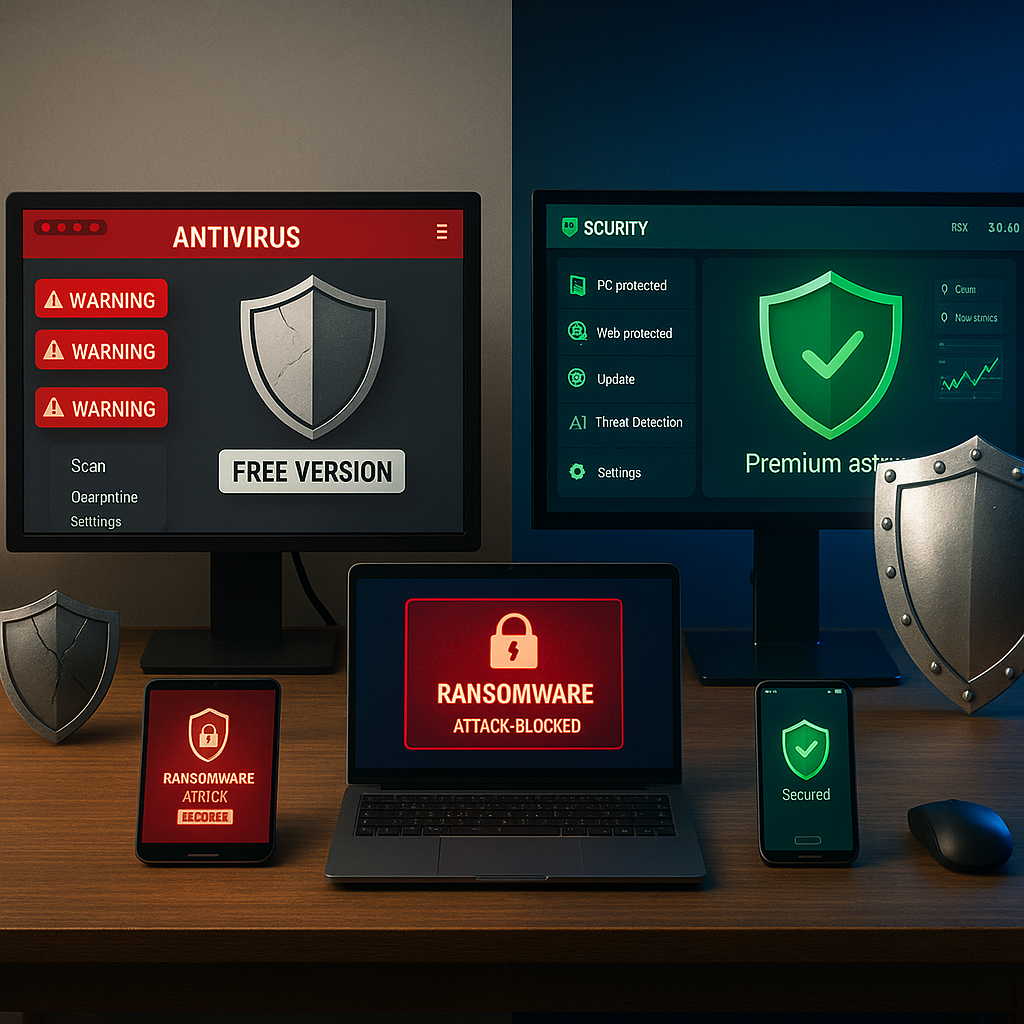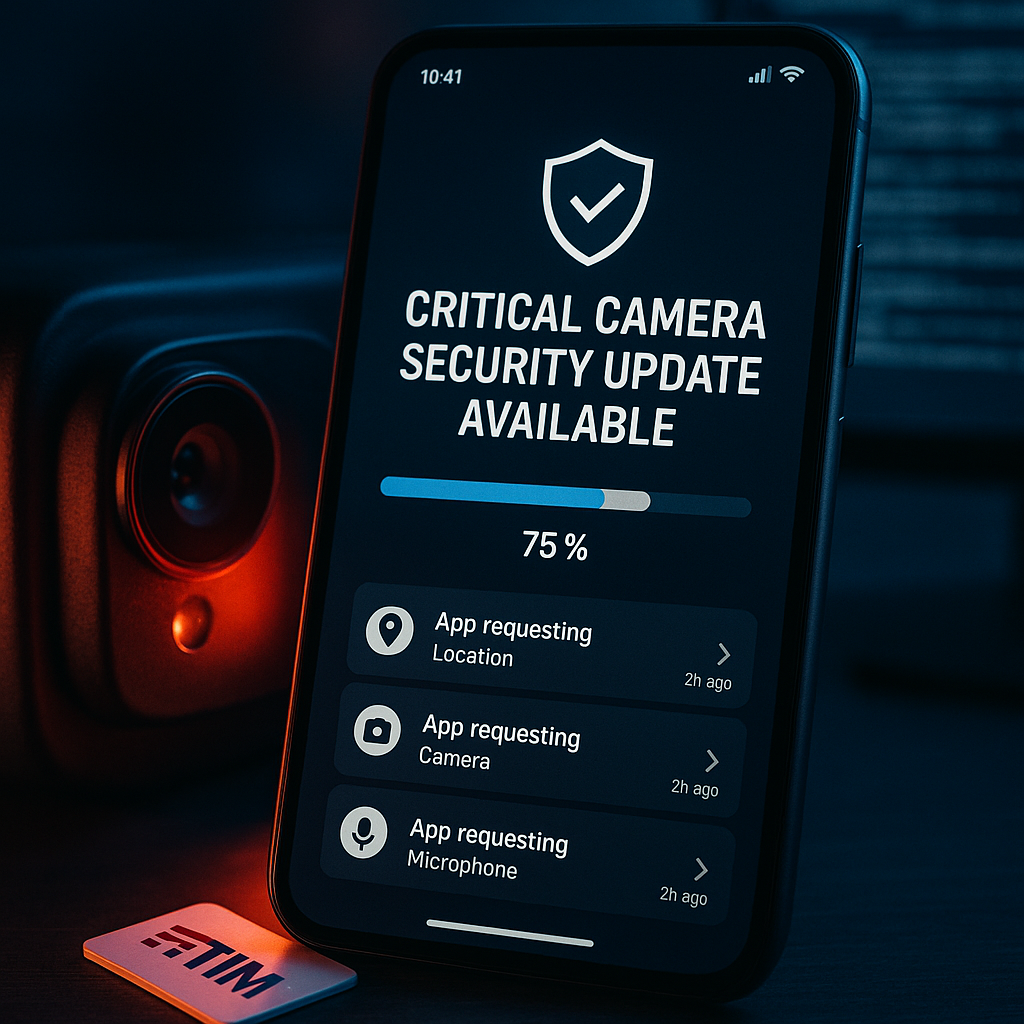Key Takeaways
- Real-time protection often reveals the true security gap. Most free antivirus apps provide basic malware scanning but lack comprehensive real-time protection. This essential feature is usually reserved for paid versions, which leaves users more vulnerable to rapidly evolving threats.
- Convenience arrives with hidden security tradeoffs. Free antivirus apps are popular for their simplicity and zero upfront cost, yet users compromise on deeper security controls and advanced protections. This tradeoff increases the risk of exposure to sophisticated cyberattacks.
- Limited feature sets can undermine overall defense. Critical safeguards such as ransomware shields, secure browsing, and phishing protection are typically restricted or missing entirely in free versions. Without these upgrades, comprehensive defense remains out of reach.
- Performance impact varies by app and platform. While some free antivirus tools operate efficiently and stay lightweight, others slow devices or generate persistent pop-ups. Comparing top free picks for 2025 is crucial for finding the right balance between protection and system performance.
- Leading free antivirus solutions provide strong yet incomplete baseline safety. The best free antivirus apps in 2025 deliver reliable malware detection, frequent updates, and robust core features. However, they still fall short of the comprehensive security and real-time defenses included in premium options.
- Choosing between free and paid antivirus depends on your risk profile. Users managing sensitive data, working in professional roles, or exposed to higher risks should consider layered, premium security. In contrast, casual users can begin with a well-vetted free option, provided they understand the inherent tradeoffs.
- Mobile devices introduce unique safety considerations. Free antivirus for Android and iOS helps block malware and phishing, but often lacks the in-depth surveillance and modules present on desktops. Securing phones and tablets requires increasing focus as mobile threats grow in sophistication.
As you read the detailed app comparisons ahead, keep these takeaways in mind. Matching your personal security needs with the right antivirus solution means navigating the intersection of cost, protection depth, and convenience. All of these are essential for effective digital safety.
Introduction
The landscape of antivirus apps is more dynamic than ever, and not all offerings are created equal—especially those that promise protection at zero cost. In 2025, the gap between robust digital security and simple, free solutions has widened, with most free antivirus apps prioritizing accessibility over advanced defenses.
Understanding the real pros and cons of free antivirus is more important than ever for anyone balancing convenience with comprehensive protection. This guide presents a clear, data-backed comparison of top security apps. You’ll discover which free tools genuinely offer real-time protection and learn about the subtle, often-overlooked tradeoffs that could impact your device’s performance and security.
Let’s explore the actual worth of free antivirus in 2025. By equipping yourself with facts and practical guidance, you can make confident choices between cost savings, strong app safety, and the peace of mind that comes with finding your ideal security fit.
Un passo avanti. Sempre.
Unisciti al nostro canale Telegram per ricevere
aggiornamenti mirati, notizie selezionate e contenuti che fanno davvero la differenza.
Zero distrazioni, solo ciò che conta.
 Entra nel Canale
Entra nel Canale
Core Features and Limitations of Free Antivirus Solutions
Recognizing both the strengths and the boundaries of free antivirus options is crucial when considering your digital defense.
Real-Time Protection Capabilities
Real-time protection stands at the heart of modern antivirus effectiveness, but it remains the biggest shortfall among free solutions. According to recent findings from the AV-TEST Institute, free antivirus programs generally deliver 15–30% less real-time scanning power than their premium versions.
Most free antivirus apps offer a basic approach to real-time protection:
- Scanning newly downloaded files and email attachments
- Monitoring for basic system changes
- Delayed threat detection (often lagging 2–4 hours compared to paid versions)
Key limitations commonly seen:
- Lack of advanced process monitoring
- Absence of network threat detection
- Minimal zero-day malware prevention
- Limited or no behavioral analysis tools
Recent performance tests indicate that paid antivirus solutions detect new threats an average of 127 minutes faster than free options. This gap is critical in today’s threat landscape where new malware variants emerge rapidly across sectors like finance, education, and healthcare.
Essential Security Features Comparison
Free antivirus apps today have evolved, offering more robust protection than previous years. Standard features now typically include:
- Basic Malware Detection
- Signature-based virus scanning
- Scheduled and manual system scans
- Simple file quarantine and removal tools
- Limited Web Protection
- Browser-based security warnings
- Malicious URL blocking
- Rudimentary phishing detection
- System Performance and Efficiency
- Modern free antivirus tools have become more efficient, demanding less from your device:
- CPU usage averages between 2–5% while idle
- Memory (RAM) usage sits between 150–300MB
- Full-system scan covers 100GB in roughly 45–60 minutes
The performance difference with paid versions has decreased, and free antivirus now delivers about 85% of the efficiency of premium tools. This is an improvement seen across PCs, laptops, and even in resource-constrained devices like tablets.
Advanced Features and Premium Limitations
While freebies have stepped up, premium antivirus solutions set themselves apart by including advanced capabilities tailored for users who require more comprehensive security.
Premium-Exclusive Capabilities
- AI-Powered Threat Detection
- Integration of machine learning to detect new malware
- Predictive identification of emerging threats
- Advanced behavioral analysis for unknown threats
- Premium version success rates climb to 97.8%, compared to 89.2% in free offerings
- Enhanced Privacy and Identity Protection
- Secure VPN services for anonymous browsing
- Integrated password managers
- File encryption and secure file deletion modules
- Specialized Protective Tools
- Dedicated ransomware shields to safeguard important documents
- Webcam and microphone protection against eavesdropping
- Financial transaction security, protecting online banking and shopping activities
These features transcend basic malware defense. In fields like healthcare and legal services, such specialized tools help safeguard sensitive patient records and confidential documents, respectively. Meanwhile, in education, privacy protections are critical for student data security.
Mobile vs Desktop Protection Dynamics
Protection objectives and challenges shift when moving from desktop to mobile platforms.
Mobile Free Antivirus Capabilities:
- Scanning of incoming apps for malware
- Basic anti-theft features like device location and remote wipe
- Limited web and phishing protection
- Battery optimization and device-boosting tools
Desktop Free Antivirus Strengths:
- Broader system scan capabilities and integration with OS security features
- Higher detection rates due to more powerful scanning engines
- Access to an extensive threat database
In free versions, mobile antivirus typically achieves about 72% of the feature set found in desktop counterparts. Paid versions close the gap to roughly 89% feature parity. As more personal and professional tasks migrate to smartphones and tablets, securing these devices becomes increasingly important (especially in sectors such as banking, retail, and telemedicine).
Performance Impact and System Requirements
As antivirus software advances, its effect on device performance and compatibility remains a central customer concern.
Resource Utilization Analysis
Free antivirus solutions for 2025 show variations in how they use system resources.
Lightweight Programs (Under 200MB RAM):
Un passo avanti. Sempre.
Unisciti al nostro canale Telegram per ricevere
aggiornamenti mirati, notizie selezionate e contenuti che fanno davvero la differenza.
Zero distrazioni, solo ciò che conta.
 Entra nel Canale
Entra nel Canale
- Avast Free Antivirus
- AVG AntiVirus Free
- Microsoft Defender Antivirus
Moderate Resource Usage (200–400MB RAM):
- Kaspersky Free
- Bitdefender Antivirus Free
Key system impact stats:
- Boot time may increase by 5–12 seconds
- File transfers experience a 3–7% slowdown
- Launching applications may be delayed by 1–3 seconds
For users working in creative industries, finance, or with sensitive research data, this impact can influence productivity. Comparing performance metrics across antivirus options is therefore crucial, whether you prioritize speed for gaming or stability for remote work.
Compatibility and System Requirements
Modern free antivirus apps are accessible and easy to install. Common requirements include:
For Windows devices:
- Windows 10 or 11 (64-bit)
- 2GB or more RAM
- At least a 2GHz processor
- 5GB free disk space
For mobile devices:
- Android 8.0 or later
- iOS 14 or later
- At least 1GB RAM and 500MB available storage
Compatibility has seen substantial progress. As of 2025, free antivirus products support around 92% of current user hardware and operating system configurations. That’s a jump from 78% in the previous generation. This means that whether you’re a remote worker with a Windows laptop, a student using a tablet, or a parent protecting the family’s phones, there is a suitable free option available.
Conclusion
Today’s free antivirus solutions have evolved considerably, offering foundational malware protection and a streamlined experience with minimal impact on most devices. Core offerings now include basic web security and resource-efficient operation. Still, notable gaps persist. Free antivirus typically lags premium solutions in real-time threat detection, AI-powered analysis, and holistic privacy protection. The absence of specialized modules like ransomware shields and identity security becomes especially critical for professionals and anyone dealing with sensitive or financial data.
For the majority of users (students, freelancers, small business owners, and families), modern free antivirus apps deliver a strong baseline of digital safety on mainstream devices. Yet those who require faster threat response or extra privacy layers (such as healthcare providers, finance professionals, or remote workers with confidential information) are better served by comprehensive, premium options.
As cyber threats grow increasingly sophisticated across all industries, making an informed choice between cost and thorough protection is not just a matter of convenience but one of responsible digital citizenship. Looking to the future, the advantage will belong to individuals and organizations who stay proactive, continually assess their security needs, and adopt solutions that keep pace with evolving risks. In many ways, digital safety is becoming a competitive edge in every aspect of life and work.





Leave a Reply